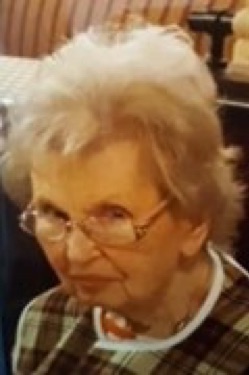![[Photos and Features]](../jpg/articlestop.jpg)
Off-Season Fun with Penfield’s Copy Cats |
Copy Cats in May
What do the Copy Cats do when the regular season of dancing is over? Why we dance, of course. And at the annual end-of-the-year picnic, held this year at the Aldrich Road lodge in Perinton, we ate and played games, and we honored special Copy Cats Rick and Donna LaDonna with the Rathke award for outstanding volunteer service to the club. Bill Ryan provided the music and calls for the Copy Cats and our recently-graduated Kittens. Pictured (L-R) are Jim Lasch, Tami Adams-King, Laurie Collins, Dave Collins, Wally King, Liz Beauter, Royce Rogers
Copy Cats in June
Several of our members attended the 68th National Square Dance Convention in Atlanta, Georgia where they attended many dance sessions as well as helpful workshops on topics such as attracting and keeping younger dancers. Pictured (L-R) are Jeff and Debbie Blood, Mary Martin and Phil LaRussa.
Copy Cats in July
Even though the weather outside was far from cold the Copy Cats had a Christmas In July dance at the Church of the Most Holy Trinity in Webster. The dance was attended by eight squares of brrrrave dancers. Santa even made an appearance, thanks to our guests from Cayuga Cut Ups who stole our banner. Now, I ask you, is that a nice thing for St. Nicholas to do? Isn’t it better to give than to receive? Ron Brown and Jeanne Harter added to the festive mood with costumes and Christmas music as they called and cued for the dancers. And, yes, there were even Christmas Cutout Cookies. Thank you, new Kitten graduates, for the creative decorations.
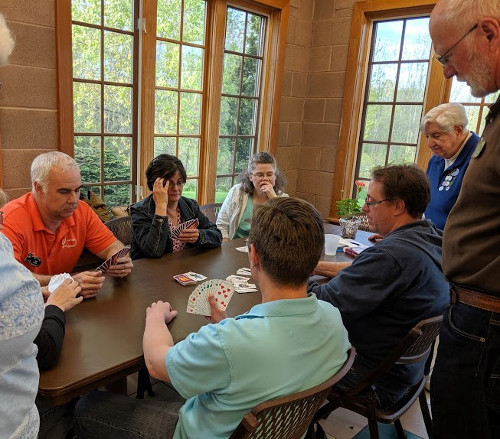
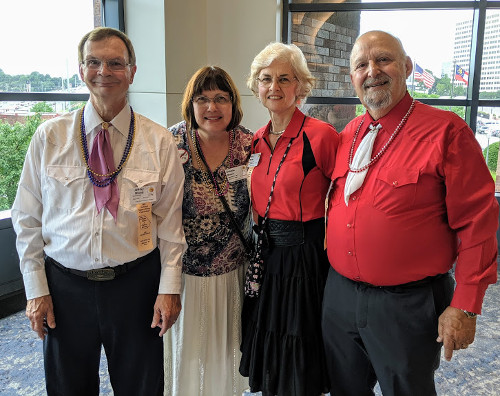
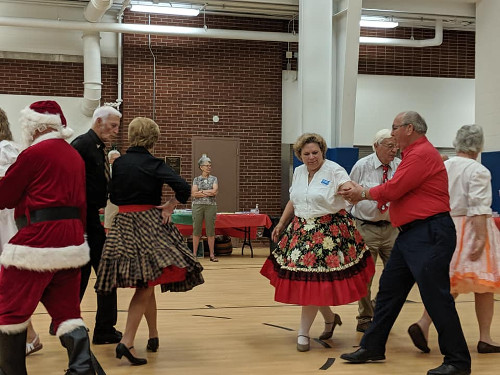
Jim and Sally Lee (Silver Squares) Receive Circle of Service Award |
On July 6, 2019, Sally and Jim Lee were presented with the Circle of Service Award by Sally Baechle. They have been square and round dancing for almost four decades, beginning with Boots N Slippers (Hilton) and now Silver Squares (Rochester). They have been officers in both clubs and have served with the Rochester Federation where they were active in promoting square dancing in our area. Jim and Sally were honored to receive this well-deserved award.
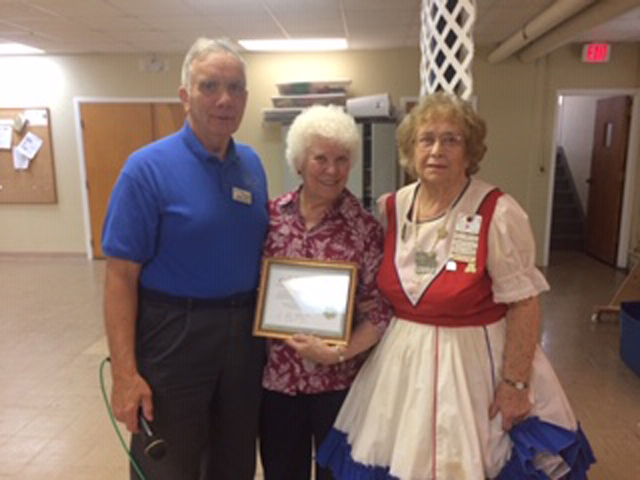
Belles ’N’ Beaus — Mainstream Mania |
The BELLES ’N’ BEAUS dance club is excited to start up
again September 9 as a MAINSTREAM club.
Some of the advantages of mainstream:
• We can blend our class into our club at a much faster rate.
• We have “snowbird’ members who go south for the
winter and upon returning they can jump right back in with no problem.
• We dance all evening with very little breakdown.
• A mainstream club allows new dancers, class members from
other clubs, and dancers who want to dance with less focus on
technical skills simply come and have fun.
Christmas Dance In July? Why Not? |
On July 20, the Copy Cats conjured up snowmen and winter fun at their “Christmas In July” dance. Caller Ron Brown and cuer Jeanne Harter provided a great evening of music, and Auburn’s Cayuga Cut-Ups stole Copy Cats’ banner … with a little help from Santa. A wonderful time was had by all.
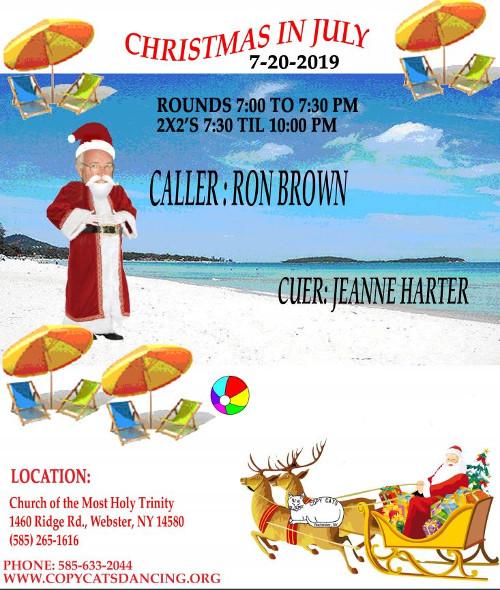
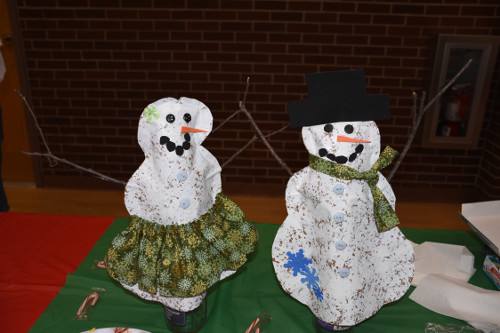
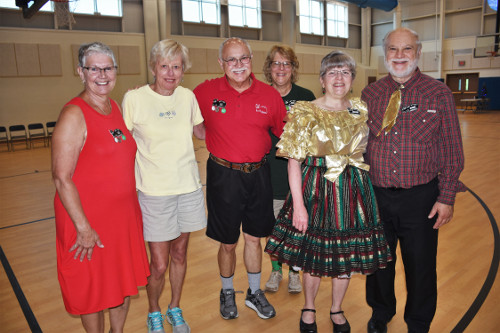
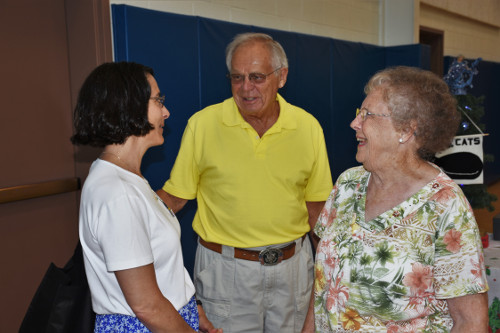
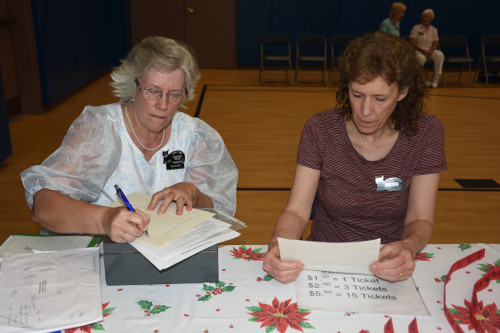
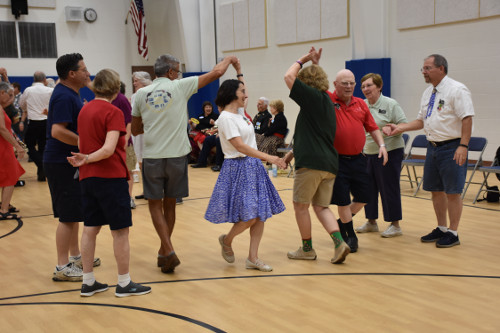
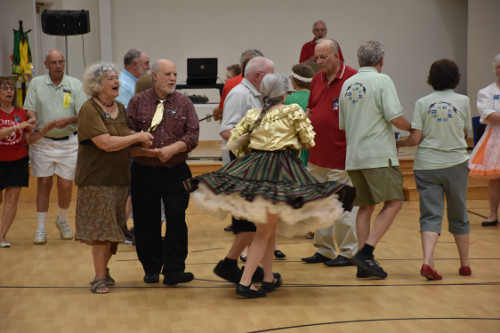
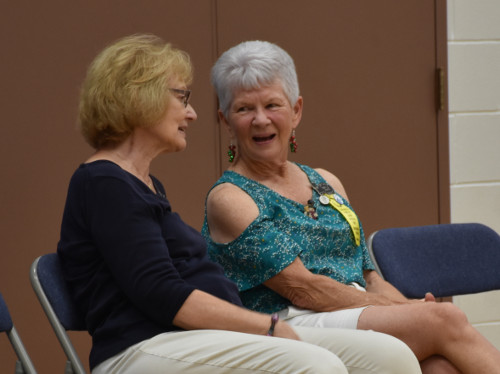
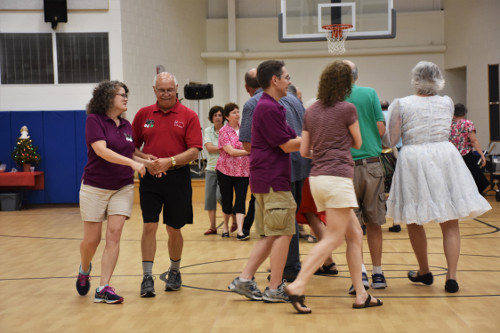
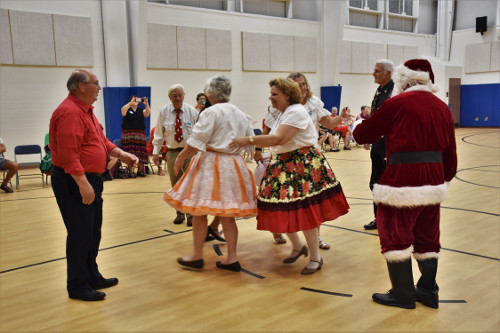
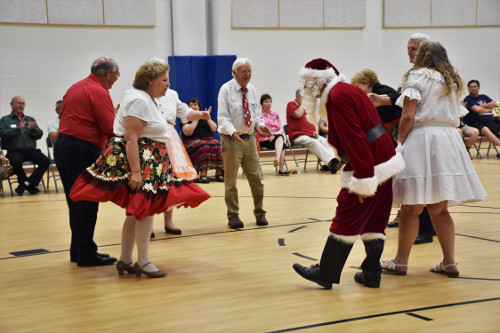
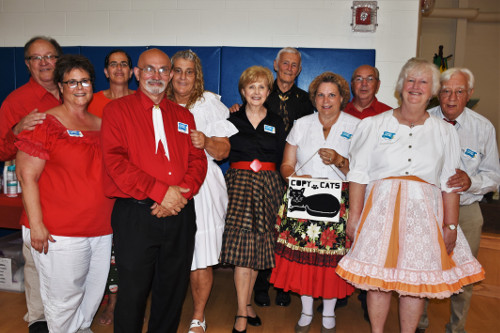
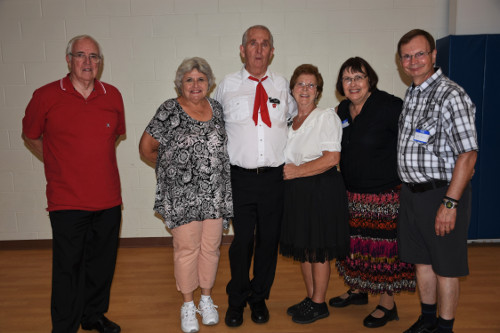
Bring a Graduate to the Fall Friendship Ball |
The 2019 Fall Friendship Ball is scheduled for Saturday afternoon,
September 28, at the First Baptist in Penfield Church (same venue as
the Copy Cats regular dances). This will be an afternoon dance,
followed by a pot luck supper.
This dance was conceived as an opportunity for new dancers and
established dancers to get together and kick off another season of
dancing. However, in its first three tries, there have been very few
recent grads in attendance. So, a few changes are planned for 2019.
Details are yet to be worked out, but in the interest of improving
attendance by recent graduates, instead of making the event
free-of-charge for all, there will be a “sliding scale” cost
for dancers. All 2019 graduates will be admitted free of charge, but
the cost for all others will be $5 per person, reduced to $3 if you
bring a dish to pass, and free-of-charge if you “bring” a
graduate.
It sounds complicated, but the idea is to encourage established
dancers to take the initiative and connect with recent graduates and
ensure that they join us for this dance.
Each club should work out how they want to make these connections. One
idea would be to come as a group, or at least coordinate your arrival,
so you can check in dancers and grads at the same time. Another
approach might be to put out a sign-up list at your September dances,
for grads and dancers to pair up in advance on paper, and agree to
check in together at the Friendship Ball. Perhaps clubs with a large
number of graduates could reach out to other clubs to find
“sponsors” for some of their grads.
At DOR, graduates received a copy of the Fall Friendship Ball flyer in
their “welcome” packet, so they are all aware of this special
dance, but that’s never been enough. We are reminded time and
again over the years that it’s the personal touch—the direct
person-to-person invitation from an established dancer—that makes
new dancers feel welcome and brings them out to dance and socialize.
Please do your part and “bring a graduate” to the Fall
Friendship Ball!
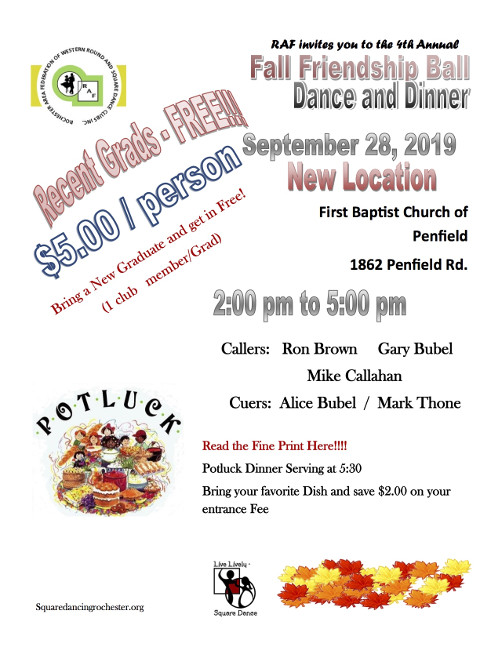
From the Archives — The Triggers Club |
Brenda Bixby sent us on a trip down Memory Lane by submitting photos
from the Triggers Scrapbook. The Triggers club was founded in 1963 by
Myron & Peg Huss, whose Daphne-Norma Leadership Award plaque is
pictured here.
Brenda also sent a newspaper clipping with a club group photo. At the
time of the photo, they danced at Parkland School on English Road. The
clipping marks the club’s 25 Anniversary, so it would have been
taken in 1988.
To find out a little more about the Triggers, we browsed the
Promenader’s online archive. (That’s a full set of scanned
back-issues going all the way back to 1962 HERE).
What we found was that the Triggers danced on Tuesday evenings and had
very similar activities to those we enjoy today. Their Club News from
September, 1990 is shown here, kicking off a new dance season just as
we are doing now, almost 30 years later.
That same Promenader issue carried their flyer for a special dance on
October 2, 1990, with guest caller / cuer couple Paul and Shirley
Rzepkowski from Buffalo.
Thanks, Brenda, for opening this door to our dancing heritage!
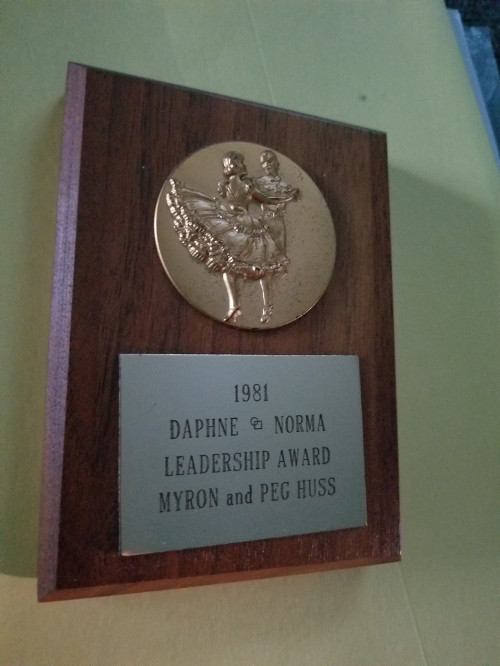
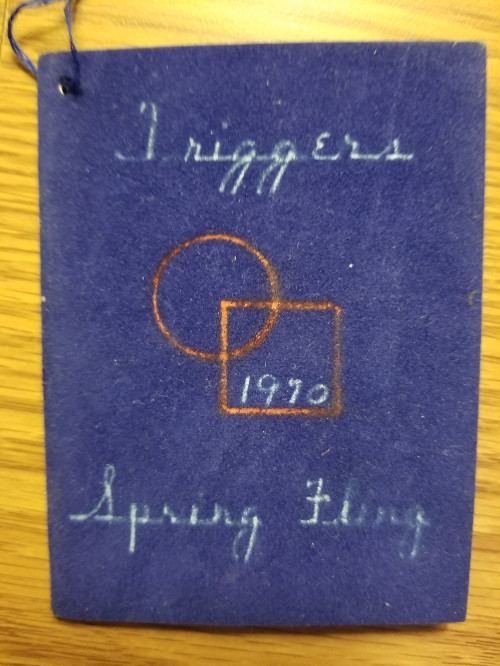
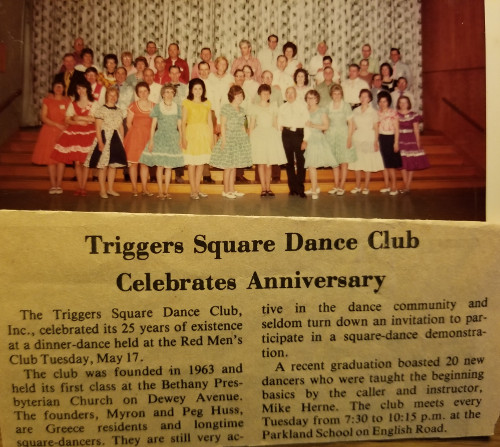
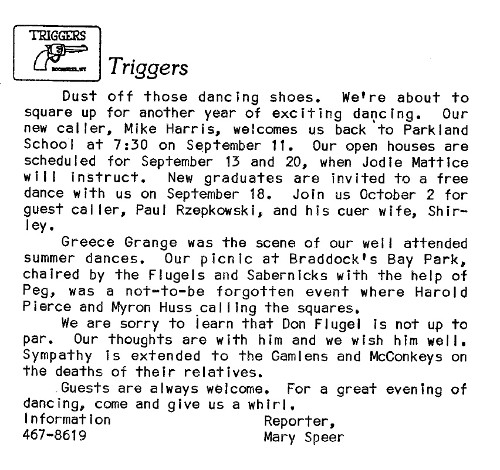
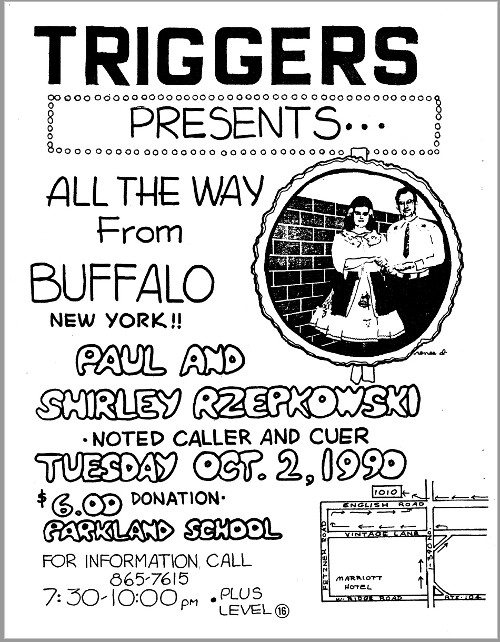
Thanking the Caller |
When we’re out for an evening of dancing and socializing, we dancers
tend to focus on … well, dancing and socializing. It’s easy to
take the music and the caller—and the cuer—for granted. But
there’s nothing easy or automatic about delivering a fun dance.
There’s preparation in advance—the selection of tunes, the choice
of patterns aand variations to call. There’s getting all the gear to
the venue and setting it up in working order. There’s the inevitable
range of dancer skills and preferences to balance through the
evening. And there’s the challenge of sustaining two to three hours
of entertaining energy—no matter whhat happened earlier in the day
or the week.
Then there’s the feedback. Every dancer knows to clap at the end of
each tip—applauding an enjoyable performance. But tthat’s so
automatic that it’s not likely to satisfy any entertainer’s need
for positive feedback on the performance.
The caller I’ve known best, long-time Village Squares caller Jerry
Carmen, told me he gauged his performance by two indicators: (1) the
dancers who came up after the dance to say “thank you” and (2)
the dancers who stayed for the full performance instead of leaving
early.
Imagine yourself at the microphone, producing an evening of music and
dance moves, and watching the crowd gradually melt away without anyone
saying goodbye.
My guess is that Jerry’s feelings on this are shared by most or
maybe all callers. I didn’t realize just how deep and far back this
ran for Jerry until I came across his column—pictured here—frofrom
the September, 1990, Promenader.
So, as your head and feet begin to ache and you start to think about
the drive home, include a few thoughts about the caller and about
expressing your appreciation. Stay to the end if you can, but if you
must go, then take a moment after your last tip to take the caller
aside and say something—even if it’s just “had a great time
tonight, but gotta get home now.”
If you’re leaving for some reason related to the dance program, then
it’s all the more important for you to say a few words to the caller
or cuer. They need to know if something needs to change.
We have wonderful callers in our area. Some have a lifetime of
experience and others are beginning to build up their experience. We
should give them every ounce of encouragement we can. Thank your
caller!
Here’s the text of Jerry’s column from September, 1990:
You think your club has the best caller in the area. His choreography
is interesting. He is fun and comfortable to dance to, always patient
and good natured. You wish to show your appreciation, but don’t know
how.
It’s 9 PM and there’s ten squares prancing on the floor. By 10 PM
only two squares remain. The caller looks about and thinks to
himself, what am I doing wrong? Why does everyone leave so early?
The dance still has another half-hour to go. By the last tip only
three couples remain, and they’re the cleanup crew. So the dance ends
early. On the way home, the caller wonders what he can do to make the
dance more exciting. Do the dancers want more challenge? Different
singing calls? Or maybe he’s wearing them down. Are the tips too
long? Too Short? These and a lot of other things go through his head
on the way home.
What our caller was experiencing was “dancer runout” (no relation to
“dancer burnout”) disease. That’s the premature outflow of dancers
that manifests itself in four groups; (1) those eager to follow the
primeval urge to “beat the traffic”, (2) those who party with friends
somewheres else, (3) those who have to get up early the next day, and
(4) older members who run out of breath by the middle of the dance.
Some clubs are afflicted more seriously than others. It appears to be
contagious, affecting most of the regular members and leaving the
guests to fend for themselves at the end of the evening. There Is no
known cure. For the first group, moving up the quitting time only
results in them leaving still earlier, inspiring others to follow
suit. A half hour before the end of the dance seems to be the magic
number. What none seem to realize is they are affecting the
performance and self-confidence of the caller. If they wish to
indicate they did not particularly enjoy the caller’s performance,
this is the way to do it. On the other hand, if they really wish to
show appreciation to the caller, the very best way ls to stay for the
whole show.
Would you go to a play and leave before the last act? When you leave
the dance early, you’re cutting out the caller’s last act. Most
callers plan their programs to have a beginning, middle and end. The
last tip is usually meant to be special. It may be a relaxer or a
rouser, but always something the caller thinks he does especially
well.
The old-time dancers can remember that twenty or more so year ago the
average dance lasted from 8 to 11 PM and most stayed to the end. Some
callers can remember completing the last tip and having the dancers
clapping for more. Attitudes seemed different then. I can remember
it was customary for dancers to line up after one of these sessions
and file past the caller, thanking him for the great time. What has
changed? Have the callers changed, the dancers, or maybe square
dancing itself?
You really don’t have to line up like in the old days and thank him.
You don’t have to tell him what a great dance he called. All this
means nothing if you walk out the door early. If you respect your
caller, think he does a fine job, and wish to show your appreciation,
stay and dance the last tip. Besides, it’s good courtesy.
TIP SHEET: Dancer Position |
For most of us, the desire to become a skillful dancer isn’t the
main thing that brings us to the dance floor. What brings us is the
friendships we have formed around dancing. We learn to square dance,
and in the process, we integrate ourselves into an active and
fun-loving social exercise environment.
Many of us just want to dance well enough to keep our skills from
getting in the way of socializing—i.e. from embarrassing us or
disrupting our friends. Others are motivaated by the challenge of
learning new calls and variations on calls already
learned. Accommodating this range of goals is a real challenge for
callers, especially those who also teach classes. Teaching programs
that move dancers along at too fast a pace, combined with club
programs that don’t provide enough practice time, lead to
frustration and dropouts—graduates who don’t return.
The RAF Promotions Committee is actively working to increase available
Mainstream dance time for class members and graduates. We’ll address
those efforts in a future posting, but in this “Tip Sheet”
let’s focus on the teaching and learning.
Recently, Mike Callahan shared a November, 2017, article by Kip
Garvey. It’s written by a teaching caller for other teaching
callers, describing an important element of square dance
learning. It’s an element that takes more time for most new dancers
to develop than the “rush to Plus” allows. In Garvey’s view,
this causes many new dancers to give up and drop out. The element
he’s talking about is spatial awareness - a dancer’s sense of his
or her position in each formation. (HERE is the full text of
Kip Garvey’s article.)
In Garvey’s words:
Watch a new dancer class. Watch the dancers. See how they learn
each call. At first, they learn movements. They relate the movements
to the calls. They do not realize they are ends, centers, leaders or
trailers. … New dancers simply are not spatially aware of their
positions within formations until well into the learning process. …
New dancers do not develop spatial orientation untill they have been
square dancing for many hours, often as many as 40 or 50 hours of
dancing. Some will become spatially oriented sooner. Others will take
many more hours. Some will take years.
And later in the article:
The lack of spatial orientation results from a learning curriculum
that is too fast paced, contains too many calls and lacks the single
most important element of learning spatial orientation - time. New
dancers need time. Time is the one thing they have been deprived of
for the past three decades or more. There is no shortcut for learning
spatial orientation.
Garvey goes on to pointedly urge club leaders and his fellow callers
to revise their teaching programs. He suggests that instead of pushing
ahead to get through Mainstream and Plus in one year, teaching
programs should allow more time for new dancers to practice and
develop their spatial awareness. Not all callers or cub leaders will
agree with Garvey’s message about teaching, but there is a growing
consensus in our area that more Mainstream dance time is needed. As
discussed at this summer’s RAF Club Presidents meeting, the RAF and
club leaders are actively working on making that happen.
Meanwhile, what’s so important about spatial awareness?
Spatial awareness is important because in square dancing, where you go
(i.e. your next movement) is determined entirely by where you are
(i.e. your position) when the movement starts. It’s actually your
position, not your gender, that determines your movement in the
call. Teaching “ladies do this and men do that” gets new
recruits dancing right away because they come in the door knowing
their gender. If they have to first learn how to tell if they are ends
or centers or leaders or trailers before they start dancing, we are
likely to lose most of them after one session.
For some calls, the difference between your movement pattern and
someone else’s depends on whether you are an “END” or a
“CENTER” in the starting formation. For other calls, it depends
on whether you are a “LEADER” or a “TRAILER” in the
formation. And in many formations, you are in two positions at once,
for example a leader and a center. Which of these is the
“operative” position depends on what the next call turns out to
be—i.e. whether the next call has you working with the people beside
you or those in front of and behind you.
How quickly you recognize your position and link it to the appropriate
movement is the essence of your dancing skill. Comfortable and
resilient dancers develop the habit of mentally noting their position
at the end of each call, so as to be ready for the next call.
I don’t know how to teach square dance movement patterns or spatial
orientation awareness, but I do know how to make diagrams.
Accompanying this article is a diagram that I hope will be a useful
visual aid to hand out at square dance classes. Its purpose is to help
dancers build a mental picture of the formation they are in and
visualize their position in it. Keeping a diagram like this in mind
also makes call definitions more intelligible. (Click TIP SHEET-POSITION.pdf to
view/download/print a PDF version.
(Experienced dancers who occasionally break down their square when
they freeze on a call when they are in an unfamiliar position should
also take one of these home - maybe in a plain brown envelope, so
nobody else will know.)
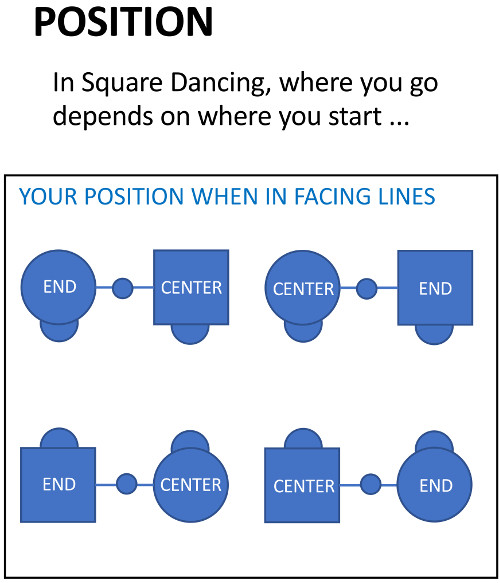
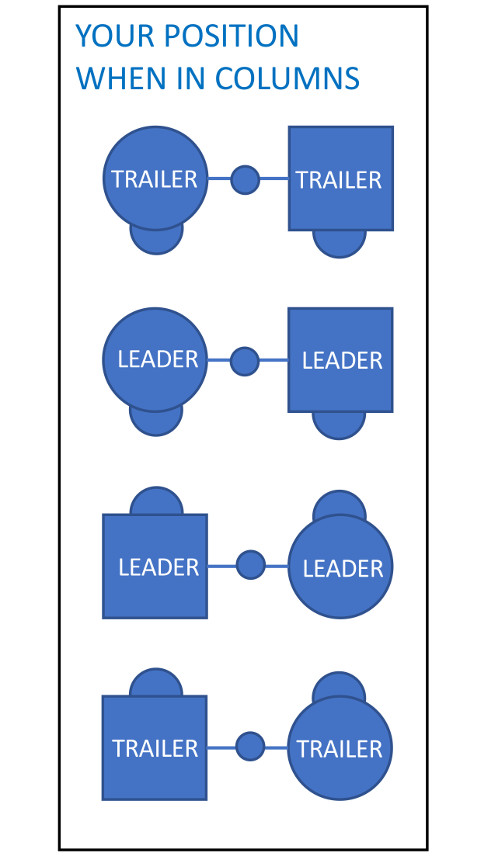
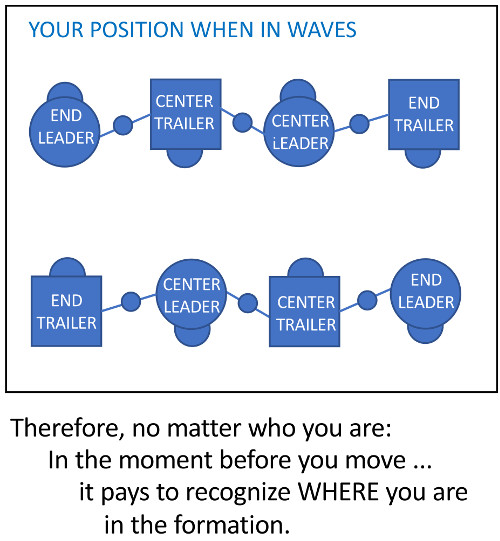

How To Be A Good Angel |
The monthly magazine American Squaredance carries a regular column
called “Callerlab Viewpoints.” The topic in the September,
2015, issue (Volume 70, Number 9) covers a very timely topic, so we
present the column below in its entirety (with minor changes to adapt
it to our area):
Callerlab Viewpoints, by Mike Seastrom
The following has been edited from “Square Dance Nebraska—Ideas.” A special thanks to Mike Bramlett for sharing some great
information on the subject of how to be a good angel.
Is your halo on straight? It is important that as many club members as
possible come to the class as “angels.” What are
“angels”? They are the wonderful people who volunteer their
time to ensure that new dancers have the best possible learning
experience.
“Angels” provide new dancers with their first real look at a
club. How “angels” behave and treat new dancers, other
“angels,” and visitors will affect class members’ decisions
regarding whether or not to join your club.
“Angels” are also role models. No matter what the instructor
and club try to communicate to the students regarding etiquette,
attitudes, or styling, class members inevitably take their cues from
what they see “angels” doing. So it is important that
“angels” be extra careful to be good role models.
Smile, be enthusiastic, and enjoy the dancing. Be friendly, courteous
and gentle. This is sometimes easier to say than do, especially if it
has been a long day. Let’s be honest; some of us have personal
agenda, perhaps disagreements with club policies, or less than cordial
relationships with specific club members. These issues are out of
place at new dancer events and must be put aside.
Although most of us do the right things instinctively, the majority of
the time it can’t hurt to reiterate certain points. The following
advice for “angels” has been extracted from several sources,
including articles in square dance publications and handouts prepared
for other clubs.
“Angels” Are Not Teachers
This is perhaps the most common misconception that can cause
problems. The primary teaching function of an “angel” is to
teach by example and be in the right place at the right time. One
important thing you can do is establish hand holds after every
move. Not only does this help students maintain their orientation in
the square, but it’s also a very good habit for every dancer to
develop.
It is always tempting to explain something your square is not getting,
and the new dancers will often ask you to do this—but you must
resist. It diverts the student’s attention from the teacher and one
of the most important things for a new dancer to learn is to listen to
the teacher/caller. Sometimes you can clarify a simple point for
students between tips; this is fine, but not while the caller is at
the microphone.
Another difficult point is just how much help you should give in
getting dancers into the right place. Dancers, after all, must learn
to do the moves on their own. To gently guide someone through a
maneuver, if they have a momentary lapse of memory, might be okay and
sometimes one can help by indicating nonverbally where a person should
go. Just remember that we accomplish little by pushing or pulling a
dancer through an action when he or she doesn’t know what was
supposed to have been done.
It is better to let a square break down rather than to use force
getting people into the right place. A broken down square is an
indication to the instructor that dancers are having problems. Be sure
the teacher is aware of problems. Raise your hand if necessary and ask
the teacher to explain something if your square is having trouble.
But be careful not to embarrass any dancer by the way you ask for
help. It is much better to say that “the square is not getting a
certain move” rather than saying “Steve is not getting a
certain move.”
Encourage students. Let them know that all new dancers make mistakes
and that things get better with practice. Also, “angels” make
mistakes too. It is good to admit to them cheerfully, as it makes the
students less tense about their own mistakes.
Club Styling
Club styling is always a major source of contention. It is important
new dancers learn the calls with standard CALLERLAB styling; that is,
without the added flourishes that are done in certain areas. The
teacher will introduce these regional differences at appropriate times
after the calls are mastered. “Angels” must use only the
styling which has been taught to the class.
This is not always easy. How many remember to Swing Your Partner
without a Twirl at the end? It is really very important not to
introduce more confusion into a new dancer’s learning
experience. Some students are going to want you to teach them how
it’s done before they have mastered the call, but you should resist
the temptation.
Some Random Additional Advice
Square Up With Everyone, not just a few friends. Seek out the new
dancer who is having difficulty and ask them to dance with you. Make
sure than new dancers are not sitting out because “angels” are
dancing.
End Conversations Promptly when the teacher begins a tip. If you are
not dancing, keep your conversations far away from the dance area.
Cheerfully Lend A Hand if you are asked to help set up or clean up,
help with refreshments, or take attendance.
Watch For security problems, accidents and dangerous situations like
spills or debris on the floor.
NotifyThe Instructor if there are problems with the sound.
Don’t Complain about the hall, the floor, the caller or anyone
attending the class.
Don’t Criticize students or other “angels.”
Remember:
Your name badge.
You are an example to the new dancers and an ambassador for your club.
Have fun! “Angels” are a key part of whether a new dancer joins
your club.
(For American Squaredance subscription information, send email to:
AmericanSquareDance@gmail.com)
Patrick J. O’Shea — Sunday, August 4 |
Patrick J. O’Shea, Chili, NY, passed away peacefully on Sunday, August
4, 2019 at age 91. Predeceased by his wife, Rita; brothers and sister,
Jerimiah, Gerald and Maureen Sauer. Survived by his children, James
(Lydia) and Karen (Ben TenEyck); grandchildren, Dennis, Ryan, Brooke
and Alexandra; great-grandchildren, Scarlett, Quinn and Presley;
brother, Daniel; special friend, Elaine Jezsik; and many nieces and
nephews. Patrick was a US Navy Veteran who served during the Korean
War.
A Celebration of Life Mass was held at St. Pius Tenth Church, 3000
Chili Avenue. Interment was at St. Pius Cemetery. Memorials may be
made to St. Pius Tenth Church or Honor Flight.
(Obituary was published in Rochester Democrat And Chronicle on
Aug. 11, 2019)
Special note from Elaine Jezsik:
It is with a heavy heart that I inform you that Patrick O’Shea went
home to be with his God, along with family & friends who passed
before him. He turned 91 on June 17th. I was privileged to be part of
his life for 20 years and I will miss him dearly. He was the kindest
man I have ever known. Patrick loved and was proud of and thankful for
his children, Jim & Karen and the rest of the family. He was also
proud of his IRISH heritage.
Pat was a member of CLOVERLEAF SQUARES for many years. As a member he
was always willing to lend a helping hand. He also served on the board
and really enjoyed dancing. We made many good friends through the
club.
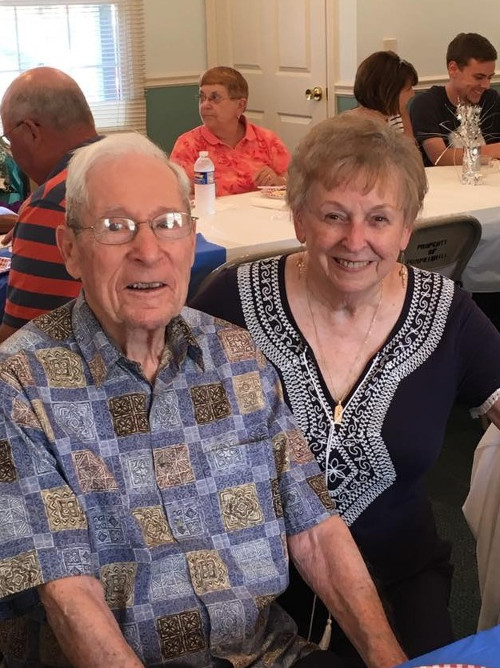
Mary C. Jackson — July 31, 2019 |
Mary C. Jackson passed away in Chili on Wednesday, July 31, 2019 at
age 76. She was predeceased by her son, Rich, and is survived by her
husband of 50 years, Robert; children, Mark and David (Rebecca
Kingman); brother, Tom (Trudy) Cravens; sister, Julie (Steve) Edmonds;
brother-in-law, Doug (Lynn) Jackson; several nieces, nephews and dear
friends.
Mary received a Bachelor’s Degree from Ohio University and a Master’s
Degree from the University of Rochester. She was employed through the
years at Strong Memorial Hospital, Ortho-Clinical Diagnostics and
Emery and Scuro DMD. She was an active member of the Parkminster
Church and Pearce Memorial FMC for many years. Mary was a part of the
Rochester Oratorio Society for many years and enjoyed reading,
gardening, singing, spending time with family and engaging in
light-hearted mischief. She was a beloved friend to all who knew her.
Starting in the mid 90s, Mary and Bob square danced with the Country
Twirlers club, where they were members until it closed down. More
recently, Mary was an active member of Silver Squares. At square
dancing, she was known for her sense of humor and wonderful smile! She
will be greatly missed.
A Celebration of Mary’s Life was held Saturday, August 10 at
Parkminster Presbyterian Church, 2710 Chili Ave. Private Interment at
Mt. Rest Cemetery, Bergen, NY. In lieu of flowers memorials may be
made to American Cancer Society or InterVaristy Christian Fellowship.
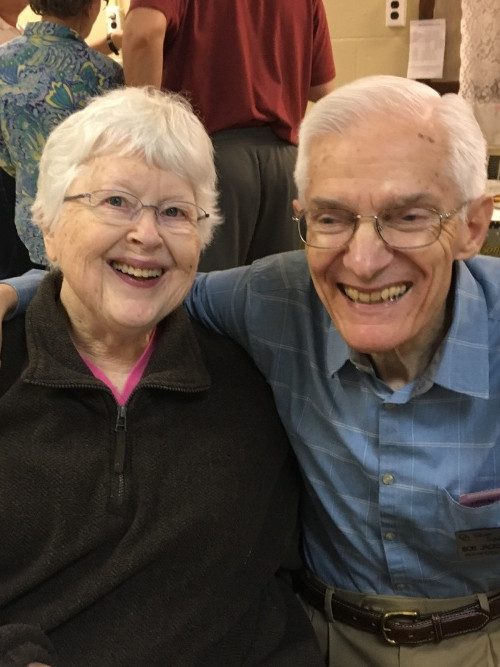
Paula Louise Schumacher — June 10, 2019 |
Paula Louise Schumacher (maiden name MacKenzie, Ott) of Baldwinsville,
NY, passed away unexpectedly on June 10, 2019 at the age of 61. She is
survived by her husband of 40 years Ray Allen Schumacher, mother Mary
Lou Ott (Edwards), father Melvin Ott, daughter Amy Lynn Schumacher,
grand-daughter Thalia River Schumacher-Schmidt and son-in-law Kevin
Schmidt.
Paula was a devoted wife, mother, grandmother, and daughter. She was
born in Detroit, Michigan on December 14, 1957. As a child, she moved
with her family to Holland, Michigan, where she met Ray, became
childhood friends and then high school sweethearts. They were married
in 1978 and moved to Syracuse, NY in 1980 to start a life and family.
Paula was an enthusiastic genealogist. She used historical records to
trace her family history hundreds of years back to the Highlands in
Scotland and Poland. She delighted in helping other people to discover
their heritage. Paula loved to laugh, travel, take cruises, care for
her dog, and knit for her family. She enjoyed square dancing with her
husband and served as President of the Shirts ’N’ Skirts Square Dance
Club in Fulton, NY.
Services were held on Saturday, June 22, 2019 at the Maurer Funeral
Home Moyers Corners, 3541 State Route 31, Baldwinsville, NY 13027.
Contributions may be made to CNY SPCA, 5878 E Molloy Road, Syracuse,
NY 13211.
(Obituary was published in The Holland Sentinel on June 18, 2019)
Special note from Ray Schumacher:
Paula and I started square dancing with the Shirts ’N’ Skirts Square
Dance Club of Fulton, NY. We took lessons and graduated mainstream in
2010/2011. Over the summer of 2011 we learned to dance at the Plus
level. In 2013 we became presidents of the club and served until
2016. After a two-year respite, Paula resumed the club presidency for
the 2018/2019 term. Paula and I were learning A1/A2 square dancing
with the Enovators of Weedsport, NY. Paula was an active member of the
Shirts ’N’ Skirts and helped organize club events such as the
Club’s 60th Anniversary, Dance-O-Rama Baskets and ALS Elaine Eno
Memorial Dance.
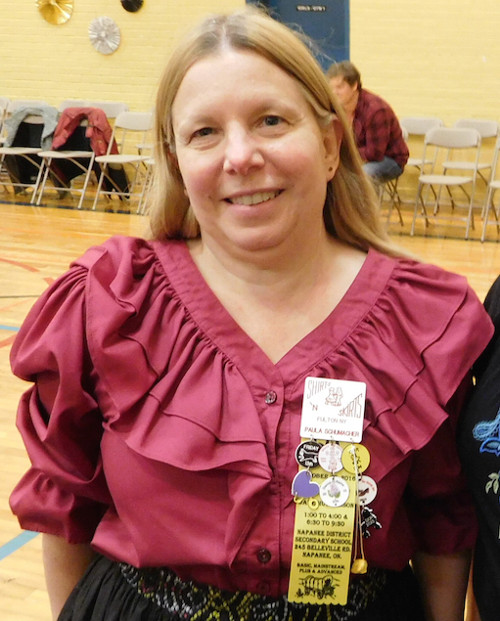
Alice Ann (Elgrim) DeFelice |
Alice Ann (Elgrim) DeFelice, 83, of LeRoy NY, passed away on August 1,
2019 at Strong Memorial Hospital surrounded by her family.
Special note from Jan Bencic:
Alice was born in Trenton, NJ on October 6, 1935 to the late William
and Helen (Hart) Elgrim. She grew up in the family home in nearby
Yardville and attended Hamilton High School, graduating in 1955. She
married Angelo DeFelice on November 21, 1959 and together they raised
their family in LeRoy.
Alice, fondly known as “Mrs. D,” was an active member of the
community. Over the years she participated with cub scouts and girl
scouts, the LeRoy Volunteer Ambulance, LeRoy-Stafford Senior Citizens,
LeRoy Chapter of Beta Sigma Phi, and the Ladies Auxiliary of the
Botts-Fiorito American Legion Post among many others. She enjoyed
cooking, camping, crafts, and time with her family, but most of all,
Alice enjoyed square-dancing each week with her husband with the
Batavia Silver Stars club and the former Promenading Bees
club. According to Angie they danced all their married life, which is
close to 60 years.
Alice is survived by her husband of 59 years, Angelo, her children,
David (Paul Scherbak) DeFelice, Joseph (Mariellen) DeFelice, and
Debora (David) Bailey, grandsons Freeman, Anthony, Nicholas and
Christopher DeFelice, Eddie and Luis Bailey, her sister, Dorothy
Moore, of Whiting, NJ and many nieces, nephews and cousins. She is
preceded in death by her parents, her brothers, William, Francis,
Eugene, Raymond and Kenneth Elgrim and her sister, Eileen Prine.
Memorial donations may be made to LeRoy Ambulance Service, Inc.,
P.O. Box 56, LeRoy, NY 14482 or the American Legion, 53 W. Main
Street, LeRoy, NY 14482.
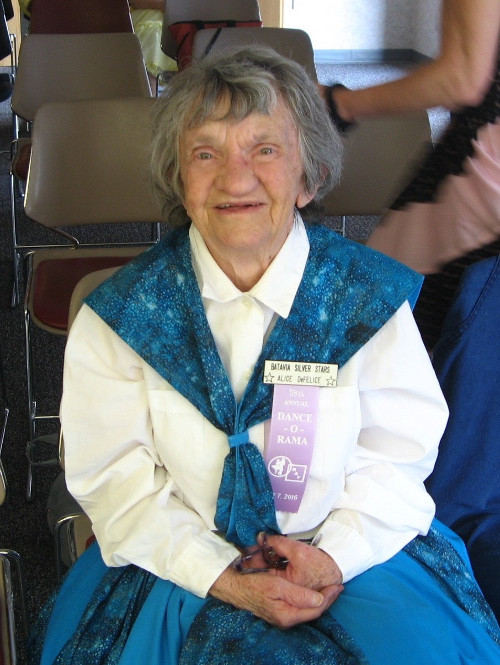
Donna Marie Murdock McCagg — June 4, 2019 |
Donna Marie Murdock McCagg, aged 84, passed away on June 4, 2019 at
her home in Honeoye Falls, NY after a courageous battle with
cancer. She was born May 17, 1935 in Fowlerville, Michigan to William
W. Murdock and Mary (Murdock) Clark and was one of six children.
Donna graduated from Hartland High School and Spring Arbor University
in Michigan. She went on to study nursing at Roberts Wesleyan College
and earned her Master’s degree from the University of Rochester,
NY. This provided her with a long career at Genesee Hospital in
Rochester, as well as Rochester General and F.F. Thompson Hospital in
Canandaigua, NY. She was a Girl Scout Leader, a member of the Grand
Squares Square Dancing Club, as well as her local walking club and the
National Susan B. Anthony Museum and House. She also had many
leadership roles in the Honeoye Falls United Methodist Church, where
she was a member for over 45 years. She played in the bell choir and
made it her job to make sure the church flower beds were always in
bloom. Donna was the most generous person; always thinking of others
and was loved by so many.
Donna is survived by her husband of 60 years, Raymond McCagg, children
Marty McCagg of Quincy, MA and Mark (Tammie) McCagg of Charlotte, NC,
granddaughter Hallie McCagg, sister Sharon (Howard) Fredenburg of
Linden, MI, brother Jack (Dinah) Murdock of Anthony, FL and Ilva
Hamzaj, their exchange student-turned-second granddaughter, of
Albania. She was preceded in death by her parents, William Murdock and
Mary (Murdock) Clark, as well as her brothers William and David, and
sisters Wilma and Jill.
Memorial service was held at Honeoye Falls United Methodist Church, 31
East Street, Honeoye Falls, NY on Wednesday, July 3, 2019, with Pastor
Mary Rublee officiating. A light reception will follow.
In lieu of flowers, you may consider a donation to Honeoye Falls
United Methodist Church or the Susan B. Anthony Museum and House in
Rochester, NY. To leave a condolence, please visit
www.mertonkaysfuneralhome.com
Special note from Carol Ann Stahl:
In June Grand Squares lost one of our longest-dancing club members,
Donna McCagg, after a valiant battle with pancreatic cancer. Donna and
her husband Ray joined the square dancing community many years ago,
when Grand Squares was Lima Grand Squares, a club founded in 1961 and
located in Lima. They continued to dance with the Grand Squares and
followed the club as it relocated to Henrietta in 2001. For the past
10 years, she and Ray were the only other officers of Grand Squares
and, as such, their efforts and support played a big part in our
club’s survival. Countless times she provided help with refreshments,
special dances and even financial assistance when funds were tight.
But Donna’s presence was felt in many other pursuits. Her field of
expertise was nursing and she worked for many years in various aspects
of her profession. She enjoyed walking and gardening and was a member
of the Susan B Anthony House and a long-time member of Honeoye Falls
United Methodist Church, where she played in the bell choir and
watched over their flower gardens.
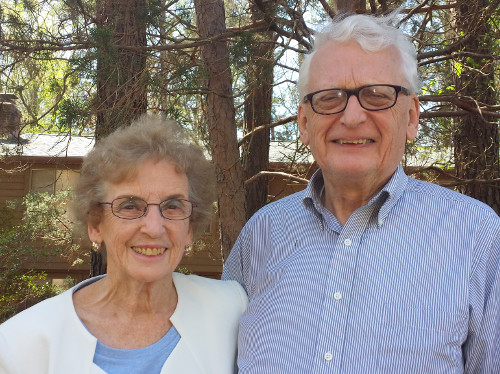
Marjorie Hamlin — August 11, 2019 |
Marjorie Hamlin, of Greece, passed away on August 11, 2019 at age
90. She is predeceased by her husband Andy Hamlin. She is survived by
brother, Al (Avis) Alexander; daughter Michelle (Miles) Bliss; sons,
Thomas (Corrine), Michael (Marilyn), Mark (Karen), Terry (Joanne); 11
grandchildren; 14 great-grandchildren; many nieces and nephews.
Marjorie loved her family and was a good friend to many. A long-time
member of the American Sewing Guide in Greece, Tecumseh Squares,
Silver Squares, and the DS&W Campers. She volunteered at the
Greece Ecumenical Food Shelf & Clothes Closet.
Family and friends gathered Tuesday, August 20th at St. Lawrence
Church (1000 North Greece Rd.) for her funeral mass. Interment will be
at the Holy Ghost Cemetery at a later date. Expressions of sympathy
may be sent in her memory to the Greece Ecumenical Food Shelf at 500
Maiden Lane, Rochester, NY 14616. Arrangements Schauman-Sulewski F.H.
